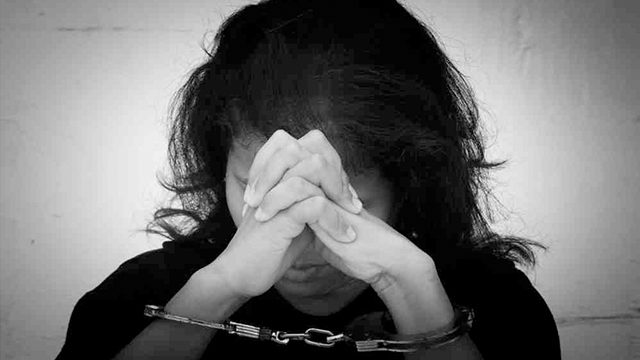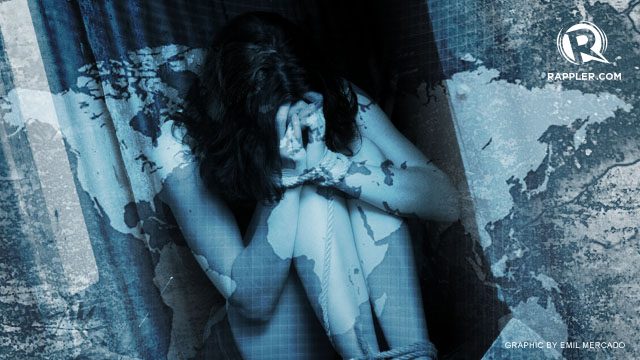SUMMARY
This is AI generated summarization, which may have errors. For context, always refer to the full article.

Editor’s Note: This article was first published by Newsbreak Magazine in 2007. The writers, interns then at Newsbreak, have since become prominent reporters – Paterno Esmaquel II is now with Rappler, while Ryan Chua now works for CGTV News in Beijing. Figures in this story have been updated by Rappler researcher Jodesz Gavilan. Unfortunately, the scourge of human trafficking continues to this day.
MANILA, Philippines – Eighteen-year-old Julie (not her real name) was working in a beerhouse in her hometown of Cebu when an opportunity difficult to ignore presented itself.
Alicia Tongco, who introduced herself as an owner of a talent management agency in Manila, offered to make her an actress and to become her manager. It was an opportunity she couldn’t pass up.
Ignoring her parents’ admonition not to leave, she left for Manila with Tongco in November 2003. Tita Bing, as Tongco was fondly called by her “talents”, allowed Julie to live in her house for free along with other women.
Everything seemed all right, until Julie was peddled to customers hungry for sex. She was sold 9 times to different men.
600 kilometers away from home, Julie worked not as a movie star as Tita Bing had promised, but as a sex slave.
Hers is a story common in the Philippines and throughout the world. Julie is just one of about 400,000 women trafficked within the Philippines annually, according to the US State Department’s Human Rights Report.
All over the world, over 10 million Filipino men, women, and children are subjected to sex trafficking and forced labor, according to research done by the US government in 2014.
But while Julie’s story is now part of reported cases and statistics on human trafficking, many people, mostly women and children, suffer in silence, their stories unknown and hidden in this underground global business that generates about $32 billion (P1.5 trillion)* a year. Many trafficked persons are not as lucky as Julie, whose traffickers were convicted in 2005.
Away from home, trafficked persons end up in brothels, sweatshops, farms, or in any other place they were made to believe was paradise.

What is human trafficking?
Although one case may differ from another, most human trafficking cases follow the same pattern, according to a report of the United Nations Office on Drugs and Crime (UNODC): (1) people are abducted or recruited in a country of origin; (2) transferred through transit regions; and then (3) exploited in a destination country.
The UNODC cites 3 elements that constitute human trafficking:
- the criminal act of recruitment, transportation, transfer, harboring, or receipt of persons within or across national borders
- by means of: threat or use of force, coercion, abduction, fraud, deception, abuse of power or vulnerability, or giving payments or benefits to a person in control of the victim
- for the purpose of exploitation, which includes, at a minimum, exploiting the prostitution of others, other forms of sexual exploitation, forced labor or services, slavery or similar practices, and the removal of organs
“At least one element from each of these three groups is required before the definition applies,” the UNODC report stated.
That Tongco tricked Julie to believe she would be a movie star and that she transported her from Cebu to Manila, where she was exploited as a prostitute, qualifies Julie’s story as a human trafficking case. With or without the victim’s consent, any case similar to this would still be classified as human trafficking, because no person would ever agree to be exploited in the first place.
Unlike human smuggling, human trafficking involves coercion and subsequent exploitation once the victim is brought to another city or province within the country, or to a foreign land. Trafficked persons are usually forced to engage in prostitution, illegal labor, begging, pornography, sex tourism, organ sale, and other jobs where they are exploited and taken advantage of.
Next only to the trafficking of drugs and guns, trafficking in persons is now the world’s third most profitable organized crime. Hundreds of thousands of people, mostly from Asia, are trafficked every year.
As a major source of migrant workers all over the world (it has 7 million migrant workers worldwide, according to the International Labor Organization), the Philippines is no stranger to human trafficking, “a lucrative underground economy” inside the country, said the Visayan Forum Foundation.
The UNODC, in fact, ranks the Philippines as “high” in terms of incidence of human trafficking.
According to a 2016 Trafficking in Persons report, the usual destinations for trafficked persons in the Philippines are Metro Manila, Metro Cebu, central and northern Luzon, and urbanized areas in Mindanao.
Trafficking, it added, also occurs in tourist destinations such as Boracay, Angeles City, Olongapo, Puerto Galera, and Surigao.
How it’s done
Ferdinand Lavin, former chief of the Anti-Trafficking Division of the National Bureau of Investigation (NBI), said that prospective recruits are usually promised decent jobs in urban areas within the country or abroad, where job opportunities are commonly perceived to be abundant.
From 2003 to 2015, data from IACAT show that 246 individuals have been convicted of human trafficking in the country
“If these people were recruited in the Visayas or Mindanao, they have to be transported to the urban centers, because the urban centers are the places for exploitation,” he said.
Recruiters usually scout for potential recruits in local communities, aided by headhunters who know the community and its residents well enough. These headhunters help recruiters convince parents to allow their children to leave. Often, the recruiters give parents cash, making it even more tempting for them to send their children to work.
To facilitate transit, a recruit’s personal documents, such as his or her birth certificate, are faked. Once in transit, they are not allowed to talk to anyone outside the group and to handle their legal or travel papers.
Upon reaching their destination, the recruits are told that their transportation expenses, along with other incurred expenses, would be deducted from their salary. Having huge debts to pay, they then begin to work, not as sales ladies or caregivers or any other job promised them, but as prostitutes, laborers on bondage, or even beggars, according to a primer of TUCP (Trade Union Congress of the Phillippines).
Taking action
Widespread as it is, human trafficking is a global menace that world leaders have been wanting to stop.
A significant milestone is the United Nations Convention against Transnational Crime, adopted by the UN General Assembly during its Millennium Meeting in November 2000.
The convention and its two supplementing protocols, opened for signature in December of the same year, was described by the UNODC report as “the first serious attempt by the international community to answer the global challenge of transnational organized crime with a global response in the form of international law.”
In the Philippines, as a response to the convention, Congress passed the Anti-Trafficking in Persons Act of 2003, or Republic Act (RA) 9208. It was also part of the country’s commitments as a signatory to the UN Protocol to Prevent, Suppress, and Punish Trafficking in Persons, Especially Women, and to the Convention on the Elimination of All Forms of Discrimination Against Women.
The Philippines belongs to Tier 2 of the US State Department’s 2015 Trafficking in Persons Report, which means it does not fully comply with the minimum requirements of the agency’s Trafficking Victims Protection Act, but is making significant efforts to do so
RA 9208 set up policies to eliminate trafficking in persons, especially of women and children. It also established the necessary mechanisms to curb the problem, and imposed penalties of as much as P5 million and life imprisonment.
In line with this, the Inter-Agency Council Against Trafficking (IACAT) was also formed to address human trafficking in the country. It consists of 6 government agencies and 3 non-government organizations, and is chaired by the justice secretary.
The IACAT is tasked, among others, to: formulate policies and programs aimed at preventing human trafficking; assist victims in the filing of cases; train personnel who will directly address cases of trafficking; and engage in information and education campaigns with local governments.
Despite these, however, many still fall prey to trafficking due to poverty, lack of job opportunities, conflict in Muslim Mindanao, and the inability of young children to continue going to school, according to a fact sheet prepared by the Visayan Forum.
The Visayan Forum adds that as criminal organizations continue to grow and expand, there still are problems such as the ease of obtaining fake documents and the lack of cooperation from neighboring countries.
From Tier 2 in 2015, the Philippines now belongs to Tier 1 of the US State Department’s 2016 Trafficking in Persons Report, which means that the government “fully meets the minimum standards for the elimination of trafficking.”
These requirements include vigorous investigation and prosecution of trafficking cases, severe punishment for traffickers, and persistent efforts to purge other forms of trafficking, among others.
From 2003 to 2015, data from IACAT show that 246 individuals – including Tongco and her husband – have been convicted of human trafficking in the country. (READ: Human trafficking convictions: How has government fared?)
According to the 2016 Trafficking in Persons report, the Philippine government convicted 42 traffickers, including five for online child sex trafficking and two for forced labor, from 2015 to 2016. It also convicted two immigration officers and charged 5 officials allegedly complicit in trafficking.
The report added that the police investigated 329 alleged trafficking cases – an increase from the 282 suspected cases in 2014 and 155 in 2013. The National Bureau of Investigation, meanwhile, conducted 40 operations which yielded 151 suspected traffickers and the investigation of 67 sex trafficking cases and 4 for forced labor.
For forced labor, victims were usually engaged in “the fishing, shipping, construction, education, nursing, and agricultural industries, as well as in domestic work, janitorial service, and other hospitality-related job” across the Middle East, Asia, and North America.
There is existing support for victims but the government should also focus on “long-term care.”
“The lack of long-term care, absence of mental health services, and familial involvement in facilitating exploitation left many victims vulnerable to re-trafficking,” the report said. – with a report from Jodesz Gavilan/Rappler.com
*$1 = P47
Add a comment
How does this make you feel?
There are no comments yet. Add your comment to start the conversation.